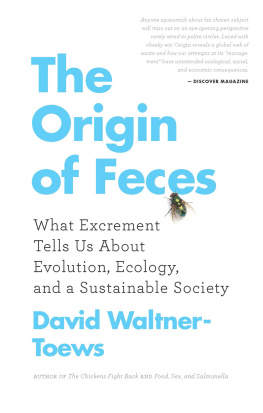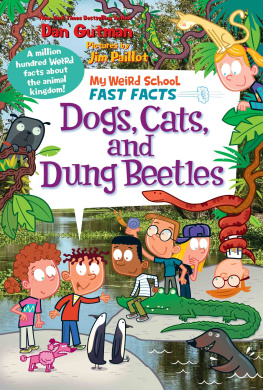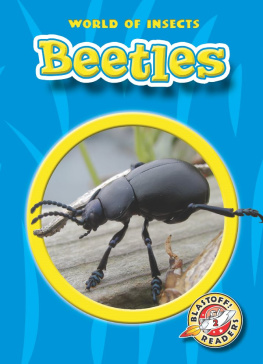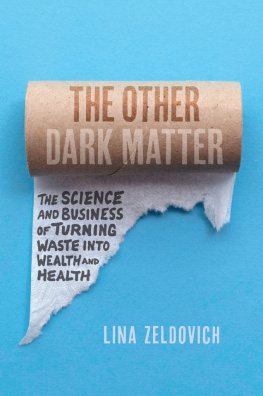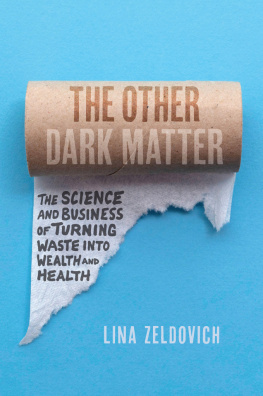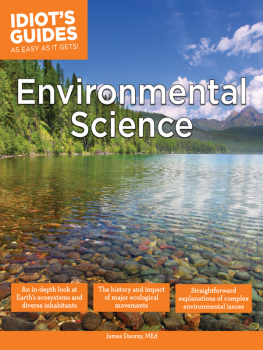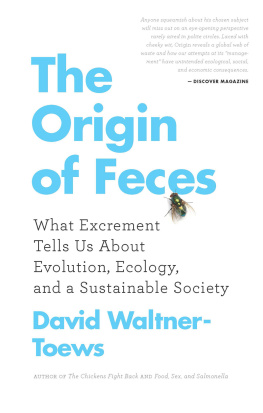... all prejudices come from the intestines.
FRIEDRICH NIETZSCHE
This book is for the late Bruce Hunter (August 3, 1950October 19, 2011), friend, colleague, farmer, veterinarian, ecohealth pioneer, global citizen, a man who really knew his shit.
I miss him.
PREFACE
Dung Beetles
and the Girl
on the Airplane
Our single-prop four-seater plane made a low swoop over the short runway, sending the gangly giraffes, monkeys, and impala loping and leaping over the red dirt into the shelter of the trees in the wooded grassland. In the days that followed, from our safari truck, we saw lion cubs and lionesses playing, kitten-like, in the shadow of our vehicle. We were charged by a huge female elephant, her ears fanned out wide to the sides. Shes bluffing. Sit still, said the guide. We froze. She stopped suddenly, twenty meters away, turned, and walked slowly back to rejoin her family. We thawed in the slow heat. Over gin and tonic, we watched the hippos lolling in the river; we heard them grunting and crashing past our cabin at night. We glimpsed the hyenas retreating into the darkness as our Maasai guide, lantern and spear in hand, led us back to our cabin after dinner. Bee eaters bright flashes of green and white and black darted and swooped into and out of small caves in the earthen cliffs along the river as our boat cruised past. Storks, stilts, spoonbills, and sandpipers trod daintily in the shallows.
Several days into our safari retreat, in the baking late-morning heat, ten of us followed two guides through green-streaked, straw-colored grasses, between ash-gray tree skeletons, flat-topped Terminalia spinosas (those classic African trees that photograph so well against the setting sun), and gnarled, deep green shrubs. It was the dry season in the Selous Game Reserve in Tanzania, the most astounding and exuberantly diverse wildlife park in all of Africa. Almost everyone else in our group was on the lookout for more elephants, lions, Cape buffalo, and warthogs, and nervously excited about the possibility of encountering them without the benefit of an escape vehicle. The effect was enhanced by the fact that Mpato, one of the guides, was carrying a rifle big enough to bring down a large, angry beast, should that be necessary.
To the dismay of the others on our walkabout, I had also corralled the guides into helping me find animal scat. What kind of an idiot comes to Africa to look at shit? Well, Im a veterinarian, so maybe it fits.
A small white pile of feces, away from a lake-sized widening in the Rufiji River, was probably hyena. The white indicated a carnivore, the crushed bones of its prey bleaching in the hot sun. A similar whitening (and hence carnivore) pile closer to the lake was probably from a crocodile. Small pellets in a heap were male impala marking territory, as well as providing nitrogen and phosphorus for plants. Female impala scat were a more scattered whisper across the landscape, and less a megaphone to announce ownership. Buffalo dung pies were flat, circular pats like domesticated cow dung, but firmer. Zebra feces, as we might have expected, were more horse-like, kidney-shaped, and darker than buffalo dung. Hippo dung on the path was like that of an elephant a big cylindrical sausage but wetter and with less fiber. The increased water content is associated with a lower concentration of nutrients, meaning it is less attractive as a food source for other species than elephant dung. The lower fiber concentration also means hippo dung is less useful for making paper than elephant dung. Hippos, who cannot see well, use a tactic that would have saved Hansel and Gretel, with their dainty bread crumbs, considerable grief. They mark the path to and from the river with their dung when they go on nighttime food foraging and pillaging expeditions, so they can use it to find their way back from the riverbank. Hippos are thus moving nutrients from the water to the land and, when they defecate in the water (which they also do), back to aquatic systems.
Each of the scats I saw along the trail in Tanzania told me something about the animals and their ecological places in this landscape, and the ways in which they have physically changed the landscape (eating plants, stomping paths, transferring seeds). Nevertheless, looking at animal scat was still vaguely unsatisfying. What I really wanted to see, much to the dismay of my fellow safari-ists, most of whom were honeymooners, were the queens of the wilderness dung beetles. I think I was, at first, somewhat amused by the notion that there are animals that literally eat shit. What did they look like? How did they do it?
I was heading back to my tent after the walk when Eduard, one of our two guides, came running after me. He and Mpato had found some dung beetles near the camp, hard at work! Strangely, as Eduard told me about this amazing find, the other tourists disappeared.
You go, said my wife. I have some important reading to do.
Their loss, I thought as I followed Eduard a hundred meters down the path to where Mpato was guarding a large pile of elephant dung with his hunting rifle. I crouched next to him, the sun beating down on my head, the sweat trickling down the middle of my back.
If I was disappointed with what I saw, I did not show it, although I had secretly wished for a re-creation of the scene described by two researchers in 1974; they had observed 16,000 dung beetles attack one 1.5-kilogram pile of elephant dung and eat, bury, and roll away the whole pile within two hours. I had to remind myself that seeing even two thumb-sized black beetles scuttling around the dung-pile was more than I should have expected this time of year. In the dry season, most dung beetles in the area were already hunkered underground in front of their television sets, watching reruns of Bushland Idle.
One of the two beetles was industriously pulling down chunks from the heap of dung and tamping them down to form a ball. Nearby, another beetle was busy burying his ball. The sandy earth shifted up and down with his subterranean digging movements. We squatted in the hot sun, watching the manic, obsessive beetles at work. If Mpato and Eduard were puzzled at my interest, they were too polite to show it.
Just when we thought he seemed done, when the walnut-sized sphere of dung twice his size looked perfect to me, the beetle would pull down another piece and tap it into some imperceptible imperfection. Finally he started rolling the ball away from the dung pile, uphill, over twigs, his hind end up against the ball, front end down on the ground. He strained and tumbled over a small branch and rolled into a little gully, still clinging to his large ball. Then he clambered up, had a look around at the lay of the land, and started pushing again. Periodically, he dug down into the earth or under the leaf litter, then came back up and resumed pushing. He pushed and tumbled his way some eight meters from the dung pile, uphill almost all the way, until he finally started digging seriously, his ball sinking into the leaf litter, heaving once or twice, and then sinking from view.
The other beetle, nearest to the dung pile, made another, smaller, ball, dug a hole, pushed in the ball, and then came back out and pulled in more dung. Both beetles were probably males, who are stronger than females, and who usually do the rolling. Sometimes, males and females will roll the ball together, bury it, dig a tunnel nearby, have sex, and then insert the fertilized eggs into the ball. If another male comes along that wants sex with the female, the two males lock horns and try to push each other out of the tunnel. According to some researchers, these battles for sex have resulted in some beetles that can pull more than 1,000 times their own weight a person, say, pulling six double-decker buses full of people. It would not be the first time that a male has gone to the gym to improve his chances of finding a sexual partner.
Next page
